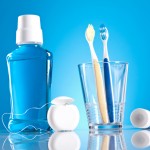
While oral malodour is considered common its prevalence is a little uncertain, as epidemiological data has been based on subjective assessment. Oral malodour can be serious enough to cause personal discomfort and social embarrassment. Volatile sulphur compounds (VSCs) hydrogen sulphide (H2S), methyl mercaptan (CH3SH) and dimethyl sulphide (CH3)2S produced by Gram- negative anaerobic oral bacteria are important component of oral malodour.
The aim of this review was to assess the effectiveness of a dentifrice (DF), a mouthwash (MW), tongue cleaning (TC), or any combination of these as adjunct to toothbrushing on intra-oral malodour and tongue coating as compared to toothbrushing alone in systemically healthy patients, when used for a minimum follow-up period of 2 weeks.
Methods
The Cochrane Central Register of Controlled Trials (CENTRAL), Medline and Embase databases were searched. Randomized Controlled clinical Trials (RCTs) comparing a dentifrice (DF), a mouthwash (MW), tongue cleaning (TC), or a combination against toothbrushing alone or toothbrushing and placebo MW or DF with a follow up period ≥ 2 weeks of were considered. Two reviewers independently screened the studies, extracted data and assessed methodological quality. Because of study heterogeneity a narrative summary was presented.
Results
- 12 RCTs (10 parallel design; 2 crossover) were included
- 4 were considered to be at low risk of bias, 6 at moderate risk and 1 at high risk
- 5 evaluated MW; 5 dentifrice and 2 a combination of MW & DF.
- None of the included studies evaluated the effect on tongue cleaning as a primary intervention.
- There was considerable heterogeneity in study design, evaluation period, study population, number, gender, and age of patients.
- The majority of studies provided a significant reduction in oral malodour when evaluating products with an active ingredient (incorporated into a DF or a MW) used adjunctively to toothbrushing. The added value of tongue cleaning over a MW was evaluated in one study.
- The majority of papers did not report on adverse events during the follow-up period. The reported side effects mainly focused on tooth staining or on subjective perception
Conclusions
The authors concluded:
The collective evidence regarding the adjunctive use of products such as dentifrices, mouthwashes, and tongue scrapers for reducing oral malodour is, in general, unclear. For mouthwashes containing the active ingredients chlorhexidine + cetylpyridinium chloride + zinc (CHX + CPC + Zn) and zinc chloride + cetylpyridinium chloride (ZnCl + CPC) most evidence was available. The strength of a recommendation to use these products was graded to be ‘weak’.
Comments
This review interrogated 3 large databases looking for RCTs investigating the use of mouthwashes, dentifrices and tongue scrapers for the management of oral malodour. A limited number of studies were found that provided weak evidence for their role in reducing oral malodour. A 2012 review by Bloom et al (Dental Elf 22nd March 2012) that focused just on mouthwashes but included both RCTs and controlled trials included 12 studies suggested that;
all mouthwashes with active ingredients had beneficial effects in reducing oral malodour in both short- and longer-term studies.
While a 2008 Cochrane review by Fedorowicz et al that also focused on mouthwashes, included just 5 RCTs and suggested that;
Mouthrinses containing antibacterial agents such as chlorhexidine and cetylpyridinium chloride may play an important role in reducing the levels of halitosis-producing bacteria on the tongue, and chlorine dioxide and zinc containing mouthrinses can be effective in neutralisation of odouriferous sulphur compounds.
Links
Slot DE, De Geest S, van der Weijden FA, Quirynen M. Treatment of oral malodour. Medium -term efficacy of mechanical and/or chemical agents: a systematic review. J Clin Periodontol. 2015 Apr;42 Suppl 16:S303-16. doi: 10.1111/jcpe.12378. PubMed PMID: 25682952.
Dental Elf -22nd March 2012 – Using a mouthwash may have a beneficial effect on bad breath
Fedorowicz Z, Aljufairi H, Nasser M, Outhouse TL, Pedrazzi V. Mouthrinses for the treatment of halitosis. Cochrane Database of Systematic Reviews 2008, Issue 4. Art. No.: CD006701. DOI: 10.1002/14651858.CD006701.pub2.

Mouthwashes and toothpastes can improve oral malodour – http://t.co/OKZ20SBDAy
Antibacterial mouthwashes may improve bad breath – http://t.co/OKZ20SBDAy
Weak evidence to support mouthwashes for bad breath – http://t.co/OKZ20SBDAy
Don’t miss – Mouthwashes and toothpastes can improve oral malodour -http://t.co/OKZ20STes6
[…] Mouthwashes and toothpastes can improve oral malodour […]